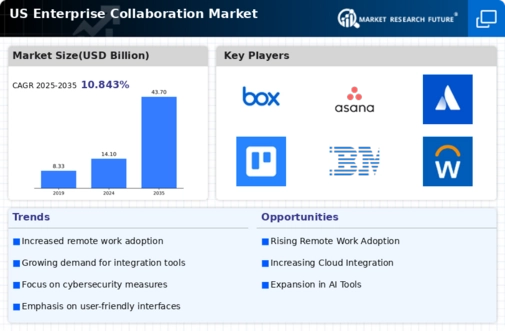The enterprise collaboration market is characterized by a dynamic competitive landscape, driven by the increasing demand for seamless communication and collaboration tools among organizations. Key players such as Microsoft (US), Slack Technologies (US), and Zoom Video Communications (US) are at the forefront, each adopting distinct strategies to enhance their market positioning. Microsoft (US) continues to leverage its extensive ecosystem, integrating collaboration tools within its Office 365 suite, thereby fostering user retention and expanding its user base. Meanwhile, Slack Technologies (US) focuses on enhancing user experience through continuous innovation and integrations with third-party applications, positioning itself as a versatile platform for team collaboration. Zoom Video Communications (US) has shifted its focus towards hybrid work solutions, emphasizing the importance of video communication in a post-pandemic world, which appears to resonate well with organizations seeking flexible work arrangements.
The business tactics employed by these companies reflect a concerted effort to optimize their offerings and adapt to evolving market demands. The competitive structure of the enterprise collaboration market is moderately fragmented, with several players vying for market share. This fragmentation allows for diverse solutions tailored to specific organizational needs, while the collective influence of major players drives innovation and sets industry standards.
In November 2025, Microsoft (US) announced the launch of a new AI-driven feature within its Teams platform, aimed at enhancing productivity through intelligent meeting summaries. This strategic move underscores Microsoft's commitment to integrating advanced technologies into its collaboration tools, potentially giving it a competitive edge by improving user efficiency and engagement. The introduction of such features may also attract new users seeking cutting-edge solutions.
In October 2025, Slack Technologies (US) unveiled a partnership with a leading project management software provider, enhancing its platform's capabilities. This collaboration is likely to strengthen Slack's position in the market by offering users a more comprehensive suite of tools, thereby increasing its appeal to organizations looking for integrated solutions. Such partnerships may also foster customer loyalty and drive user adoption.
In September 2025, Zoom Video Communications (US) expanded its product offerings by introducing a new suite of tools designed specifically for educational institutions. This strategic initiative reflects Zoom's intent to diversify its customer base and cater to the growing demand for online learning solutions. By targeting this niche market, Zoom may enhance its brand recognition and establish itself as a leader in the educational sector.
As of December 2025, the enterprise collaboration market is witnessing trends such as digitalization, sustainability, and AI integration, which are reshaping competitive dynamics. Strategic alliances among key players are becoming increasingly prevalent, fostering innovation and enhancing service offerings. The shift from price-based competition to a focus on technological advancement and supply chain reliability is evident, suggesting that future competitive differentiation will hinge on the ability to innovate and adapt to changing market conditions.























Leave a Comment